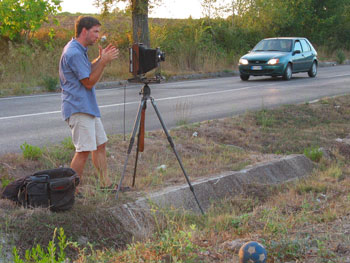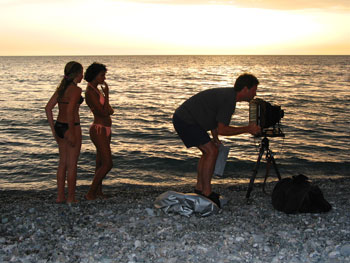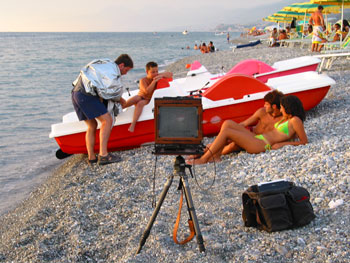 |
→ August 2004 Contents → Feature
|
Peace Stories
August 2004
|
 |
|
The exhibition of Greg Miller's work that is on display at the Redux Gallery in New York is titled "Primo Amore," or "First Love" for those of you whose Italian is as poor as mine. It's not clear whether the photographer became enamored of Italy before or after he became enamored of his Italian wife, but since he seems devoted to both, it probably doesn't matter. The other love of his life, although hopefully a distant third, is his 8x10 view camera, which he used to produce the lyrical tableaux of Italian life that are presented here. That they are tableaux is confirmed by Webster's definition of the word: A representation of some scene by means of persons grouped in the proper manner, placed in appropriate postures, and remaining silent and motionless. It would be difficult to find a more apt description of Miller's work than this succinct phrase.
Unlike the photojournalist, he uses this observed formation as the basis upon which he builds. He calls it "shoring up the picture." It is a process that sometimes leads him to a situation that bears little similarity to the original, and although at first glance these reconstructed scenes have the appearance of a captured moment, further observation reveals their careful and methodical organization. What gives them their power is the authenticity of each gesture and stance of those portrayed; they are, to quote Webster's, placed in appropriate postures. The credibility with which the photographer ensnares the viewer is a result of his understanding of and affection for the characters projected upon the ground glass screen of his camera. Great photojournalism touches a truth that is both momentary and eternal; when Miller's photography succeeds, as it does more often than not, it emulates the former but embraces, and even enhances, the latter.
One of the things that most appeals to Greg about Italian life is that it is lived so much on display, and with so little self-consciousness. Not only is cooking a public activity, but equally so is falling in love, jealousy, anger and joy. It is this openness that enables his camera to encapsulate these shared emotions with simple lyricism, and their universality, that he finds so moving. The reason that so many of his Italian photographs are of people on vacation, especially at the beach, is that he is as fascinated with and captivated by peace as war photographers are with conflict. On vacation, his subjects are at their most relaxed in the same way that a firefight shows humanity at its most aggressive. Thus, the photographs explore the emotions of love, lust, vanity, loneliness, pride and bravado, any one of which each of us experience on a daily basis. There is another element that he often introduces into his narratives, and which he describes as the third man, recalling the Orson Welles film of the same name. The third man — often a woman — is a discordant character within the scene, and one that produces tension within the relationships that the photograph depicts. A teenager sits holding an unlit cigarette on the edge of a chaise longue upon which two older lovers lie entwined. The image perfectly communicates the awkwardness and displacement of adolescence, along with some of its inevitable sulkiness. Sometimes the third man isn't even visible. A young woman embraces her boyfriend while he continues a conversation on his cell phone; the third man in this instance is the unseen person with whom he is having a conversation — his mother, maybe?
Through his love of Italy and the Italians, Miller has photographed the very soul of the country, and although his subjects remain "silent and motionless," they speak eloquently about who they are and where they are. It is a silence and stillness that the larger format imposes upon the photograph as it adds grandeur to a simple scene. I wanted to end with some clever Italian phrase to put you in the appropriate mood as you take this short Italian holiday. Because my clever Italian phrases wouldn't even fill an empty pasta box, the only one that I could come up with was "buon appetito," which, when I come to think of it, does have a certain appropriateness. Or, as the waiters at my local New York trattoria would say: "Enjoy!"
© Peter Howe
Executive Editor
|
|
Back to August 2004 Contents |
|
 By his own ready admission, Greg is not a photojournalist, although it is a calling that he holds in high regard. He is a devotee of the Leica as well as the larger format, but has found that the latter demands a technique and produces an end result he ultimately finds more satisfying. Miller is a creator, not a reporter, recognizing that the decisive moment cannot be captured on an 8x10, but has to be produced. His starting point, however, is as an observer. He will survey a scene before approaching its inhabitants to enlist their cooperation, which, of course, ruins the moment that first attracted him. Having procured their collaboration, he then attempts to get them back to the arrangement that initially caught his attention.
By his own ready admission, Greg is not a photojournalist, although it is a calling that he holds in high regard. He is a devotee of the Leica as well as the larger format, but has found that the latter demands a technique and produces an end result he ultimately finds more satisfying. Miller is a creator, not a reporter, recognizing that the decisive moment cannot be captured on an 8x10, but has to be produced. His starting point, however, is as an observer. He will survey a scene before approaching its inhabitants to enlist their cooperation, which, of course, ruins the moment that first attracted him. Having procured their collaboration, he then attempts to get them back to the arrangement that initially caught his attention. When Greg and his wife first visited her relatives in Italy, they arrived in Calabria around 11 p.m. after having driven from Rome for several hours. Naturally, dinner was still waiting for them, as was the scene of his large extended family by marriage huddled into a kitchen, illuminated by a single, naked light bulb. It was an image that was irresistible to him and his ever-present 8x10, and although everyone concerned was tired, it had to be photographed. If this was his introduction to his new Italian family, it was also their first inkling of what it's like to have a photographer as a relative.
When Greg and his wife first visited her relatives in Italy, they arrived in Calabria around 11 p.m. after having driven from Rome for several hours. Naturally, dinner was still waiting for them, as was the scene of his large extended family by marriage huddled into a kitchen, illuminated by a single, naked light bulb. It was an image that was irresistible to him and his ever-present 8x10, and although everyone concerned was tired, it had to be photographed. If this was his introduction to his new Italian family, it was also their first inkling of what it's like to have a photographer as a relative. I have looked at these photographs a lot while writing this introduction, and the more that I became accustomed to them, the more apparent was their artifice. I suppose that as someone whose career has been centered on photojournalism, I should find this sleight of eye, this deceptive intimacy, offensive, but I don't. In Miller's photography, the casual gesture is monumental, the simple moment timeless. Look at the picture of two teenagers, a boy and a girl, lying pensively on a pebble beach in the late afternoon sun, and study their faces. Their profiles have a direct lineage to the heads of Caesar on Roman coins or goddesses on the sides of urns; they are observed by a child lying on a pedalo, his face and body the replica of Raphael's cherubs so popular with greeting card manufacturers.
I have looked at these photographs a lot while writing this introduction, and the more that I became accustomed to them, the more apparent was their artifice. I suppose that as someone whose career has been centered on photojournalism, I should find this sleight of eye, this deceptive intimacy, offensive, but I don't. In Miller's photography, the casual gesture is monumental, the simple moment timeless. Look at the picture of two teenagers, a boy and a girl, lying pensively on a pebble beach in the late afternoon sun, and study their faces. Their profiles have a direct lineage to the heads of Caesar on Roman coins or goddesses on the sides of urns; they are observed by a child lying on a pedalo, his face and body the replica of Raphael's cherubs so popular with greeting card manufacturers.